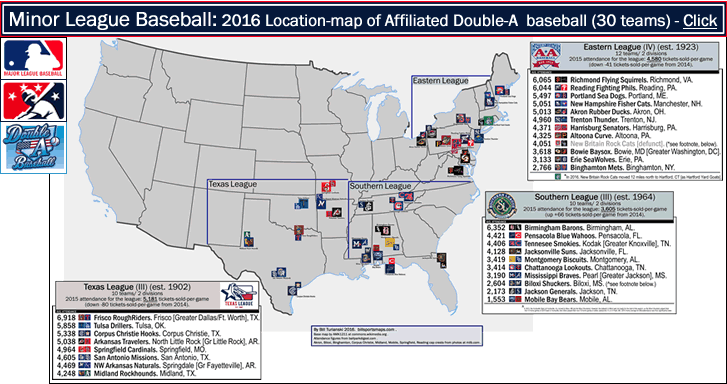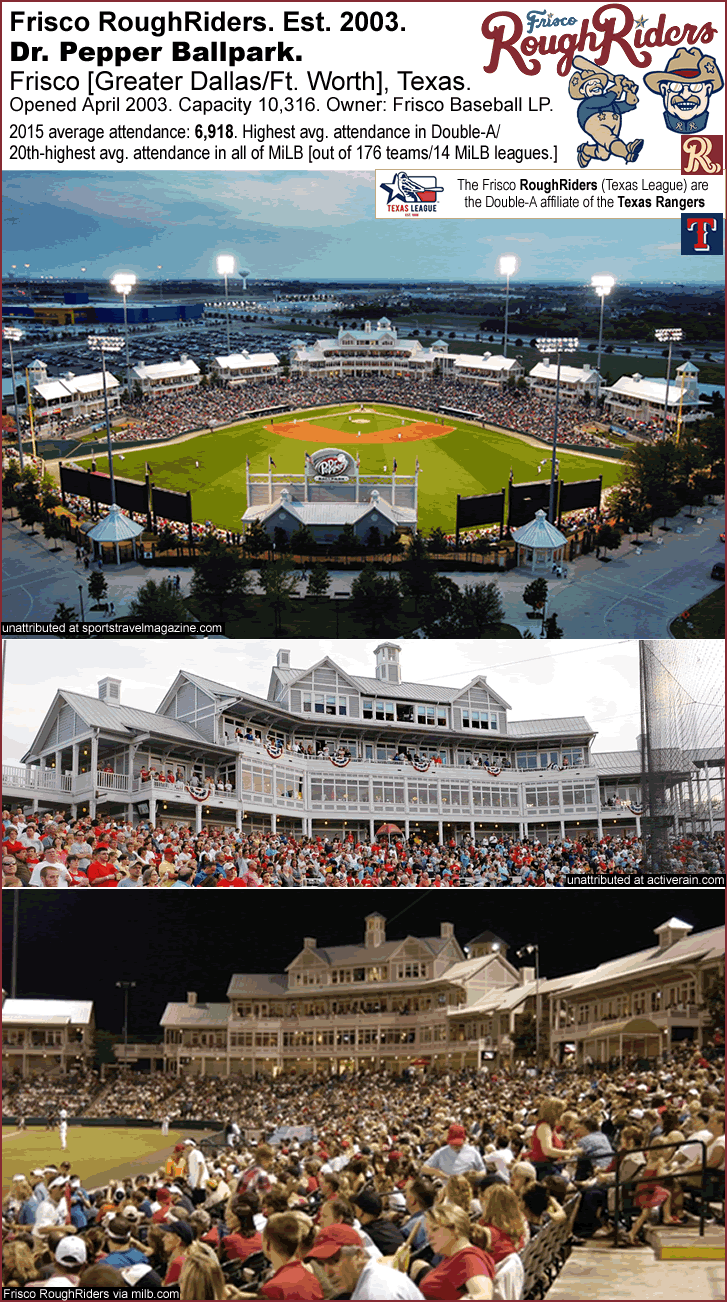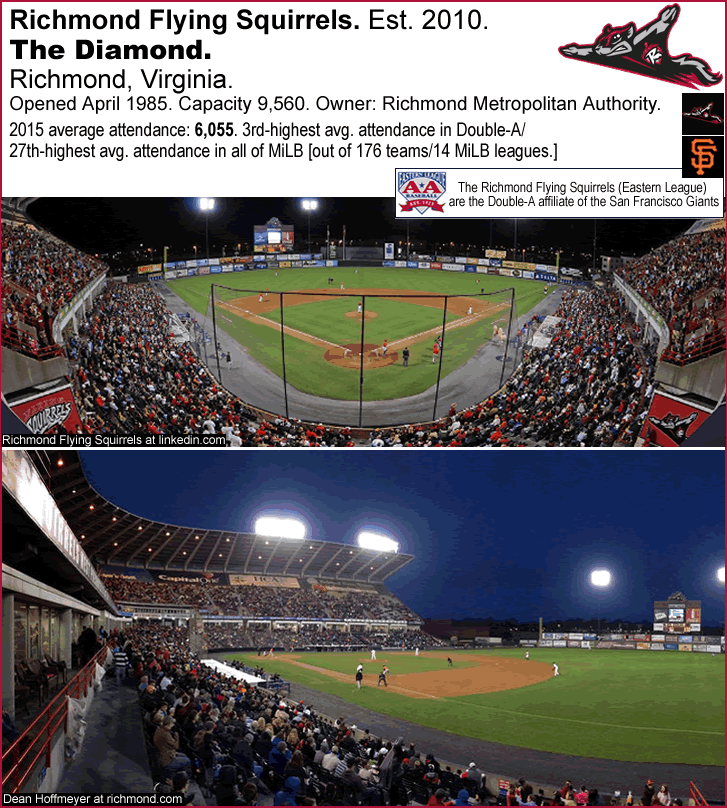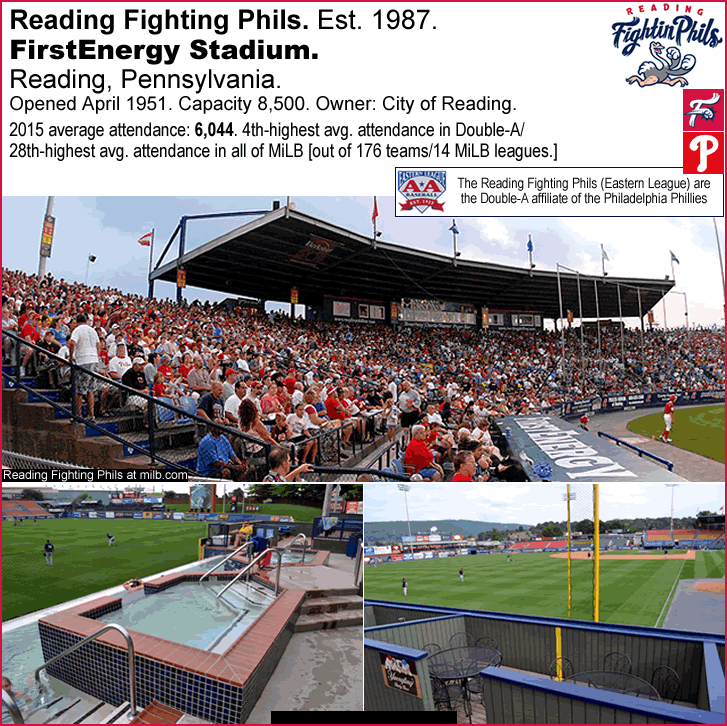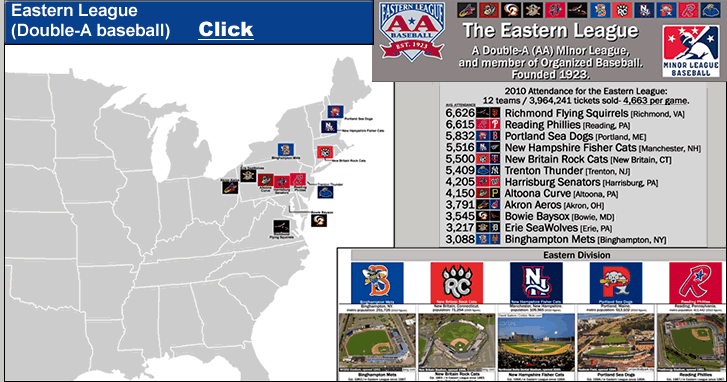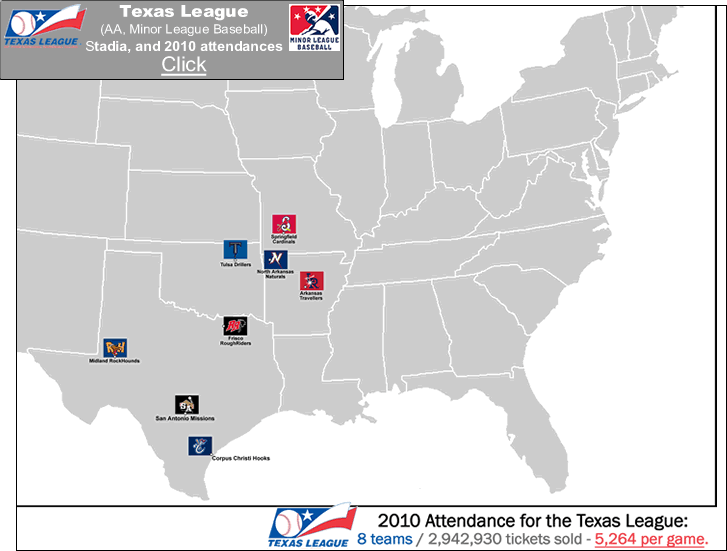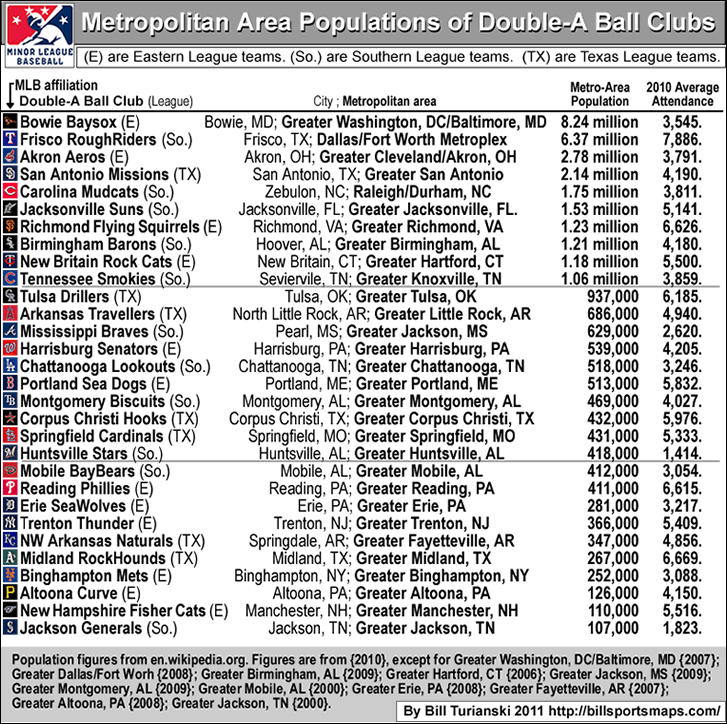Click on image below for 2011 Southern League map, with team profiles including ballpark photos
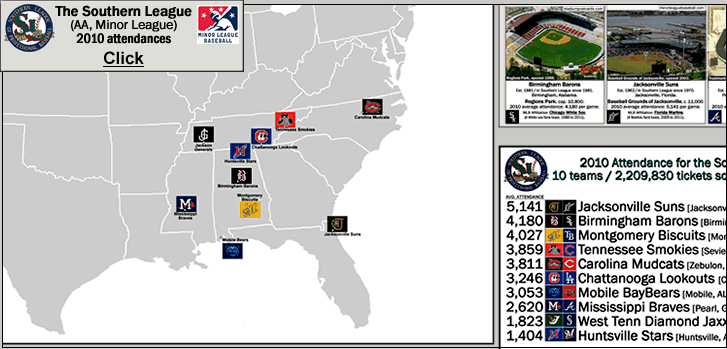
Southern League (baseball)
The Southern League is one of 3 Double-A minor leagues in Organized Baseball. Double-A is two steps below Major League Baseball. {You can see my map of all 3 Double-A minor leagues, with 2010 attendances and all 30 teams’ MLB affiliations, in this post, here.}. The modern-day Southern League was established in 1963, when the fourth incarnation of the South Atlantic League moved up one level, from Class A. and as part of Organized Baseball’s re-organization of the minor league system, became one of three Double-A leagues. The following year, 1964, the South Atlantic League (IV) changed it’s name to the Southern League (II).
Click on image below for list of Southern League statistics – 2009 average attendances; 2010 average attendances; teams’ metro areas and metro area populations; tenure [age] of teams and length of time the team has had their current MLB-affiliation; and each team’s Southern League titles…

…
The Southern League annually plays one official league game in the oldest operating ballpark in the USA – Birmingham, Alabama’s Rickwood Field {from Baseball Pilgrimages site, ‘Rickwood Field, opened 1910′}. For the 2011 Rickwood Classic on June 1st, spitball pitcher Gaylord Perry will be guest of honor, and the teams – the Birmingham Barons and the Chattanooga Lookouts – will be wearing throwback uniforms of the 1961 Southern Association teams the Birmingham Barons and the Chattanooga Lookouts. 2011 is the 50th anniversary of the 1961 Southern Association season. The 1961 Southern Association season was the last season of the now-defunct Southern Association, a league which the present-day Southern League is heir to, in terms of it’s minor league level and in the similarity of the locations of it’s teams. I think the organizers of the game this year at Rickwood Field ignored the fact that some anniversaries should not be honored. Because in 1961, 14 years after Jackie Robinson broke the color barrier, and 15 years after black ball players were playing on minor league baseball teams in other minor leagues, the 1961 Southern Association was the only professional baseball league in the USA that was still segregated. Wearing uniforms from that period, in this celebratory manner, honors, by default, the institution those uniforms came from. And in 1961, the Southern Association, by still clinging to a policy of segregation, was a racist institution. The Southern Association in 1961 was acting in a manner that would become outlawed by an act of Congress 3 years later (the Civil Rights Act of 1964).
The first Southern League existed for just 5 seasons in the late Nineteenth century, from 1885 to 1889. 13 years later, the Southern Association filled the void in the region left by the passing of the original Southern League of the 1880s. The Southern Association started in 1901 and existed for 61 seasons, from 1901 to 1961. The 8 original charter members of the Southern Association in 1901 were these 8 ball clubs (with no MLB affiliations [ie, all the 8 teams were Independents])…Birmingham Barons, Chattanooga Lookouts, Little Rock Travellers, Memphis Egyptians, Nashville Vols, New Orleans Pelicans, Selma Christians, Shreveport Giants.
The Southern Association was initially graded Class B in 1901. In it’s second season, in 1902, the Southern Association was moved up a minor league level to Class A (from 1902 to 1935). The Southern Association then was raised a level to Class A1 from 1936 to 1945; then raised another level to Class AA from 1946 to 1961 [Class AA was the equivalent of modern-day Double-A level ball.] The ball clubs in that first season that the Southern Association was a Class AA league in 1946 were (with MLB affiliations listed)…Atlanta Crackers (Independent), Birmingham Barons (Pittsburgh Pirates), Chattanooga Lookouts (Washington Senators), Little Rock Travellers (Chicago White Sox), Memphis Chickasaws (Independent), Nashville Volunteers (Chcago Cubs), New Orleans Pelicans (Boston Red Sox).
At the same point in time as this, the minor leagues saw it’s first black players play, in 1946, for the the Brooklyn Dodgers’ highest farm team, the Class AAA Montreal Royals of the International League. Those two players were Jackie Robinson and Johnny Wright. Also in 1946, the Brooklyn Class B farm team the Nashua (New Hampshire) Dodgers also had 2 black players on it’s roster – Don Newcombe and Roy Campanella. The reason for this was baseball visionary Branch Rickey, who, as General Manager of the Brooklyn Dodgers National League ball club, opposed segregation on moral grounds and felt that it was well past time for American society to see black players play in the Major Leagues…and besides, it was foolish to not tap into such a deep pool of talent that Negro Leagues ball players represented. Some of his colleagues in baseball felt otherwise, some very strongly; and some of the paying public felt otherwise, some very strongly – but those sort of people belonged in pointed white hoods. The following season, Jackie Robinson was called up to the Brooklyn Dodgers, and broke the color barrier. Two months later in June, 1947, Larry Doby of the Cleveland Indians became the first black player to play in the American League. Four years later – by May, 1951 – 6 Major League teams had integrated – the Brooklyn Dodgers, the Cleveland Indians, the St. Louis Browns, the New York Giants, the Boston Braves, and the Chicago White Sox {from en.wikipedia.com, see this, ‘List of first black Major League Baseball players by team and date‘}. By 1955, 13 teams had integrated. The holdouts were: the Philadelphia Phillies (integrated in April 1957), the Detroit Tigers (integrated in May 1958), and finally, because of a racist owner in Tom Yawkey, the Boston Red Sox (in July 1959). {see this, ‘Baseball color line‘}.
Similarly, through the early-to-mid-1950s, all the many and varied minor leagues throughout North America became integrated following the Brooklyn Dodgers’ farm system’s example, with one notable exception – the Southern Association was never integrated. By way of comparison with other minor leagues from the South…the Carolina League was integrated by 1951, and the South Atlantic League was integrated by 1953 (with one of the first 5 black players there being Hank Aaron). Eight years after that, into the 1960s, the Southern Association – the highest level minor league in the South at the time – still kept black players off their teams. For this reason, it was pretty much for the best that the Southern Association shut down after the 1961 season. The reason for it’s demise is still debated.
There is no doubt that minor league attendances were dropping pretty much everywhere in the era of the late 1950s and early 1960s. A popular theory is that the Southern Association went bust mainly due to sharp declines in attendance exacerbated by fan indifference as a result of television broadcasts of Major League ball games, which had became widespread by the late 1950s. But baseball writer Alan Barra, in his book ‘Rickwood Field‘, insists televised MLB games were not the reason. However, his point that there are a plethora of Major League ball games on most every night these days, and that doesn’t hurt minor league baseball today, fails to account for the novelty factor of televised baseball in the 1950s. Barra does feel that segregation contributed to the Southern Association’s declining popularity, and rightly points out that black fans in the South would have had a big incentive to stay away from segregated minor league ball games when black stars in the Major Leagues could be followed on television or the radio. Boycotts led by Civil Rights leaders in several Southern Association cities also contributed, most notably in New Orleans, where the demise of the Pelicans after the 1959 season is blamed specifically on the boycott that saw attendance plunge dramatically. The following season, 1960, Memphis also saw attendances decline to the point that they were only drawing around 670 per game, and the ball club folded. Plus, two teams, New Orleans and Mobile, saw their Major League affiliations dropped, and were forced to become Independent. New Orleans was dropped by the Yankees after the 1958 season; Mobile was dropped by the Indians after the 1960 season. In each case, the following season these teams had losing records and went bust at the end of the season.
Another factor could have been the rise of Little League participation, replacing the family outings to minor league ballparks. College football’s rise in popularity in the South by the late 1950s was yet another factor in undermining interest in minor league baseball in the region. There also is the fact that by the late 1950s, many minor league ballparks were in decline and were in areas that had become run down and viewed as being unsafe. Finally, there is the fact that MLB teams stopped going to Southern Association ballparks and playing the widely popular exhibition games that were a big part of the minor league experience back then, because the MLB teams’ black players would be barred by Jim Crow laws from playing. This contributed to the pall that began to hang over the increasingly empty ballparks in the league. Barra, while ultimately insisting that nobody really knows why attendances fell off so bad in the late 1950s and the early 1960s in the Southern Association, does concede the following in a footnote on page 165 – that writer Willie Morris told him “The combination of air-conditioning and television did keep a lot of people in the South from the ballparks during the summer”. This is a good point. But I think all the factors mentioned above contributed to wounding the condition of the Southern Association, but the stake to the heart was the refusal to integrate. I am holding out for the essential decency of most people, and saying that attendances dropped so precipitously because maybe enough baseball fans in the South knew deep down that, at a time when black MLB players like Roy Campanella, Don Newcombe, Hank Aaron, and Ernie Banks were winning Most Valuable Player awards, that a segregated baseball league in the late 1950s and the early 1960s was an enterprise that was just wrong, and should not be supported.
Perhaps sports writer Sam Heys, of the Atlanta Journal-Constitution, said it best, “The Southern Association chose death over integration.”
…
With the Southern Association gone after 1961, this left only the Texas League as a Class AA league, meaning in 1962 there were only 12 Class AA teams in all of minor league baseball. At the time, the Major Leagues were comprised of 20 teams (10 in each league), so just 12 Class AA farm teams supplying players to 20 big league ball clubs was a problem. To address this gap, the president of the Class A South Atlantic League, Sam Smith, led the drive to elevate the South Atlantic League (IV) (aka the “Sally League”) up one level to the Class AA status as a replacement for the defunct Southern Association. Just as this was happening, before the 1963 season, minor league baseball was re-organized, with the modern-day classifications introduced, so the South Atlantic League became a Double-A (AA) league in 1963. It would change it’s name the following year, 1964, to the Southern League (II). [Note: the South Atlantic League (V), still affectionately known as the Sally League, would be re-born 17 years late, in 1980, as a Class-A league.]
In 1963, the 8 teams from the old South Atlantic League that moved up a minor league level to AA were…Asheville Tourists (Pittsburgh Pirates), Augusta Yankees (New York Yankees), Charlotte Hornets (Minnesota Twins), Chattanooga Lookouts (Philadelphia Phillies), Knoxville Smokies (Detroit Tigers), Lynchburg White Sox (Chicago White Sox), Macon Peaches (Cincinnati Reds), Nashville Volunteers (Los Angeles Angels). Augusta and Nashville dropped out after 1963, and in 1964 when the league changed it’s name to the Southern League, two additional teams were created in Birmingham, AL, and Columbus, GA. Birmingham’s new team was again called the Barons, and was an Oakland A’s affiliate. Columbus’ team was called the Confederate Yankees. Confederate Yankees? In a league that replaced a segregated league?… Sigh. None of these original, modern-day Southern League teams remain, but 3 of those metropolitan areas – Birmingham, Chattanooga and the Greater Knoxville area have teams in the current, 2011 Southern League. [With respect to Knoxville, the current Southern League team the Tennessee Smokies can be considered as being from Greater Knoxville (they play home games 22 miles east-south-east of Knoxville, in Sevier County, in the foothills of the Smokey Mountains).]
Going back further in history, there are 5 cities that had Southern Association teams, and that currently have teams in the Southern League as of 2011. They are…Birmingham, Chattanooga, Knoxville, Mobile, and Montgomery. Half of the current Southern League is comprised of teams from cities that have Southern Association history going back 8 decades or more, and in the case of Birmingham, Chattanooga, Mobile, and Montgomery, these four cities had ball clubs in the Southern Association going back more than 100 years ago. And in the case of the Birmingham Barons and the Chattanooga Lookouts, even the nicknames have remained the same.
…
The map itself shows each team’s location with their home ball cap logo. At the lower right of the map page, 2010 Southern League home regular season average attendances are shown. At the right of the map page, each team’s home cap logo is also shown in larger size in the team’s profile box. Just below that is listed the ball club’s metro area population (and home-city [or town] population, if the team plays on the outskirts of a larger city). The profile boxes also include a photo of the team’s ballpark, the team’s year of establishment, and their year of joining the Southern League. 2010 home regular season average attendance is also listed along with ballpark capacity, and the year the ballpark opened. Finally, the profile boxes include each team’s Major League Baseball parent-club, and the length of time the team has been part of that MLB team’s farm system. The Birmingham Barons have the longest-running affiliation, 26 years now, with the same MLB team – the Chicago White Sox (1986-2011).
[Note: with minor league baseball being fundamentally a developmental entity, and not a competitive end in itself, titles are not really considered to be of the prime importance that they are in the Major Leagues. But if you are curious about titles won by the Southern League teams, that can be found at the far right on the second gif in this post, here.
...
The longest-running team in the Southern League is the Jacksonville Suns. The Suns are also the reigning back-to-back champions, winning the 2010 Southern League title (as well as winning the 2009 title). The Jacksonville Suns are entering their fourth decade of consecutive play in the Southern League. The Suns are also the highest-drawing ball club in the Southern League these days, drawing 5,141 per game in 2010. Counting the 2011 season, the Jacksonville Suns have played 42 consecutive seasons now in the Southern League [although for a 6-year period the Jacksonville Suns were known as the Jacksonville Expos]. This team was formed in 1962 and played 7 seasons as a Triple-A team, as the Cleveland Indians top farm team in 1962-63; then as the St. Louis Cardinals top farm team in 1964-65; then as the New York Mets top farm team from 1966 to 68. The Jacksonville Suns went on a 1-year hiatus in 1969, and then dropped down to the Double-A level and joined the Southern League in 1970, as a dual Montreal Expos/Milwaukee Brewers farm team. After a short return back to the Cleveland Indians’ farm system in 1971, the Jacksonville Suns began a 13-year affiliation with the Kansas City Royals in 1972. The Suns were a KC Royals farm team from 1972 to 1984. After that, Jacksonville became part of the Montreal Expos farm system again, this time for 6 seasons – from 1985 to 1990. During this period the team was called the Jacksonville Expos. A notable Jacksonville player from this era was future-Hall of Famer Randy Johnson. The 6’10” left-handed pitcher, who later became known as The Big Unit and won 303 games in the Major Leagues, spent 1987 in Jacksonville, going 11-8 with a 3.73 ERA in 24 starts.
In 1991, Jacksonville became called the Suns again, and began a 3-year stint as a Seattle Mariners farm team (1991-93). Then from 1994 to 2000, the Suns became a Detroit Tigers farm team. In 2001, the Suns began an 8-year stint as a Los Angeles Dodgers farm team. Finally, in 2009, the Jacksonville Suns became a farm team of a Major League Baseball team in the same state that Jacksonville is in, when they began their current stint as a Florida Marlins farm team [the Marlins' Triple-A team is the New Orleans Zephyrs of the PCL]. There is speculation that the Jacksonville Suns might return to Triple-A status in the near future.
Photo credits -
Carolina Mudcats/Five County Stadium…Aerial photo from Skyscrapercity.com thread, ‘Little Ballparks‘.
Chatanooga Lookouts/AT&T Field…Aerial image from Bing.com/maps/Bird’s Eye satellite view, here.
Huntsville Stars/Joe W. Davis Stadium…Photo from CityVoter.com, here.
Jackson Generals/Pringles Park photo from MinorLeagueBaseball.com, here.
Tennessee Smokies/Smokies Park…Photo from InsideSevierville.com/ ‘The Tennessee Smokies‘.
Birmingham Barons/Regions Park…Photo from Skyscrapercity.com thread, ‘Little Ballparks‘.
Jacksonville Suns/Baseball Grounds of Jacksonville photo from MinorLeagueBaseball.com, here.
Mississippi Braves/Trustmark Park aerial image from Bing.com/maps/Bird’s eye satellite view, here.
Mobile BayBears/Hank aaron Stadium aerial image from Bing.com/maps/Bird’s Eye satellite view, here.
Montgomery Biscuits/Montgomery Riverwalk stadium aerial image [facing est], from Bing.com/maps/Bird’s Eye satellite view, here.
Thanks to the contributors to the pages at en.wikipedia.org, ‘Southern League (baseball)‘.
Thanks to Baseball-Reference.com, ‘Southern League (AA) Encyclopedia and History‘.
2009 attendance figures from BizOfBaseball.com/Minor League Attendance Database, here. 2009 and 2010 cumulative and league-average Southern League attendance from Baseball-Reference.com, here.
2010 Attendance figures from NumberTamer.com/ -Numbertamer.com’s Minor League Baseball – 2010 attendance analysis [pdf] (Note, league attendances begin on page 28 of the 60 page pdf.)
Unincorporated community of Kodak, Tennessee population from Fizber.com.
No thanks to whoever wrote the following article at the MiLB/Southern League official site, ‘League History – History of the Southern League‘. This article touches on the history of the South Atlantic League that morphed into the Southern League, as well as the history of the Southern Association. But it should have been mentioned in this article that the Southern Association was never integrated. This is where a lot of people are going to get their information on the history of minor league baseball in the South, and this sort of white-washing of history is dangerous. The thing is, saying that the Southern Association was never integrated does not harm the reputation of the Southern League, because the Southern League came from a league that WAS integrated.
